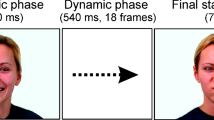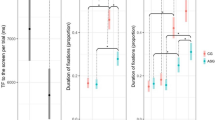Abstract
The neuro-developmental disorders of Williams syndrome (WS) and autism can reveal key components of social cognition. Eye-tracking techniques were applied in two tasks exploring attention to pictures containing faces. Images were (i) scrambled pictures containing faces or (ii) pictures of scenes with embedded faces. Compared to individuals who were developing typically, participants with WS and autism showed atypicalities of gaze behaviour. Individuals with WS showed prolonged face gaze across tasks, relating to the typical WS social phenotype. Participants with autism exhibited reduced face gaze, linking to a lack of interest in socially relevant information. The findings are interpreted in terms of wider issues regarding socio-cognition and attention mechanisms.



Similar content being viewed by others
Notes
Note that no participants received a negative FISH test. When the two participants who were diagnosed phenotypically, but not genetically, were removed from the analysis there was no change in the reported results pattern.
It is not ideal to remove these participants from the analysis; however, taking an alternative approach and inserting the maximum time allowed to view each image (5000msec) for each trial would skew the data and exaggerate group differences reported here, whilst rendering the interpretation less meaningful.
References
Bar-Haim, Y., Shulman, C., Lamy, D., & Reuveni, A. (2006). Attention to eyes and mouth in high-functioning children with autism. Journal of Autism and Developmental Disorders, 36, 131–137. doi:10.1007/s10803-005-0046-1.
Baron-Cohen, S. (1995). Mindblindness: An essay on autism and theory of mind. Cambridge, MA: MIT Press.
Behrmann, M., Thomas, C., & Humphreys, K. (2006). Seeing it differently: Visual processing in autism. Trends in Cognitive Sciences, 10, 258–264. doi:10.1016/j.tics.2006.05.001.
Bellugi, U., Lichtenberg, L., Jones, W., Lai, Z., & St. George, R. (2000). The neurocognitive profile of Williams syndrome: A complex pattern of strengths and weaknesses. Journal of Cognitive Neuroscience, 12, 7–29. doi:10.1162/089892900561959.
Bird, G., Catmur, C., Silani, G., Frith, C., & Frith, U. (2006). Attention does not modulate neural responses to social stimuli in autism spectrum disorders. NeuroImage, 31, 1614–1624. doi:10.1016/j.neuroimage.2006.02.037.
Boraston, Z., & Blakemore, S. J. (2007). The application of eye-tracking technology in the study of autism. The Journal of Physiology, 581, 893–898. doi:10.1113/jphysiol.2007.133587.
Brock, J., Einav, S., & Riby, D. M. (2008). The other end of the spectrum? Social cognition in Williams syndrome. In V. Reid & T. Striano (Eds.), Social cognition: Development, neuroscience, and autism. Oxford: Blackwell.
Brown, V., Huey, D., & Findlay, J. M. (1997). Face detection in peripheral vision: Do faces pop out? Perception, 26, 1555–1570. doi:10.1068/p261555.
Brown, J. H., Johnson, M. H., Paterson, S. J., Gilmore, R., Longhi, E., & Karmiloff-Smith, A. (2003). Spatial representation and attention in toddlers with Williams syndrome and Down syndrome. Neuropsychologia, 41, 1037–1046. doi:10.1016/S0028-3932(02)00299-3.
Burack, J. A. (1994). Selective attention deficits in persons with autism: Preliminary evidence of an inefficient attentional lens. Journal of Abnormal Psychology, 103, 535–543. doi:10.1037/0021-843X.103.3.535.
Cerf, M., Harel, J., Einhauser, W., & Koch, C. (2008). Predicting human gaze using low-level saliency combined with face detection. In J. C. Platt, D. Koller, Y. Singer, & S. Roweis (Eds.), Advances in neural information processing systems. Cambridge, MA: MIT Press.
Cornish, K., Scerif, G., & Karmiloff-Smith, A. (2007). Tracing syndrome-specific trajectories of attention across the lifespan. Cortex, 43, 672–685. doi:10.1016/S0010-9452(08)70497-0.
Dakin, S., & Frith, U. (2005). Vagaries of visual perception in autism. Neuron, 48, 497–507. doi:10.1016/j.neuron.2005.10.018.
Dalton, K. M., Nacewicz, B. M., Johnstone, T., Schaefer, H. S., Gernsbacher, M. A., Goldsmith, H. H., et al. (2005). Gaze fixation and the neural circuitry of face processing in autism. Nature Neuroscience, 8, 519–526.
Doherty-Sneddon, G., Riby, D. M., Calderwood, L., & Ainsworth, L. (submitted). The impact of the eyes. Evidence from William’s Syndrome.
Doyle, T. F., Bellugi, U., Korenberg, J. R., & Graham, J. (2004). “Everybody in the world is my friend”: Hypersociability in young children with Williams syndrome. American Journal of Medical Genetics, 124, 263–273. doi:10.1002/ajmg.a.20416.
Fletcher-Watson, S., Leekam, S. R., Findlay, J. M., & Stanton, E. C. (2008). Young adults with autism spectrum disorder show normal attention to eye-gaze information—Evidence from a new change blindness paradigm. Journal of Autism and Developmental Disorders. doi:10.1007/s10803-008-0548-8.
Fletcher-Watson, S., Leekam, S. R., Turner, M. A., & Moxon, L. (2006). Do people with autistic spectrum disorder show normal selection for attention? Evidence from change blindness. The British Journal of Psychology, 97, 537–554. doi:10.1348/000712606X114057.
Frigerio, E., Burt, D. M., Gagliardi, C., Cioffi, G., Martelli, S., Perrett, D. I., et al. (2006). Is everybody always my friend? Perception of approachability in Williams syndrome. Neuropsychologia, 44, 254–259. doi:10.1016/j.neuropsychologia.2005.05.008.
Frith, U. (1989). Autism: Explaining the enigma. Oxford: Blackwell.
Goodman, R. (2001). Psychometric properties of the strengths and difficulties questionnaire. Journal of the American Academy of Child and Adolescent Psychiatry, 40, 1337–1345.
Gosch, A., & Pankau, R. (1997). Personality characteristics and behaviour problems in individuals of different ages with Williams syndrome. Developmental Medicine and Child Neurology, 39, 527–533.
Hooge, I. T. C., & Eerkelens, C. J. (1996). Control of fixation duration in a simple search task. Perception & Psychophysics, 58, 969–976.
Jacobs, A. M. (1986). Eye-movement control in visual search: How direct is visual span control? Perception & Psychophysics, 39, 47–58.
Jawaid, A., Schmolck, H., & Schulz, P. E. (2008). Hypersociability in Williams Syndrome: A role for the Amygdala? Cognitive Neuropsychiatry, 13, 338–342. doi:10.1080/13546800802243334.
Jones, W., Bellugi, U., Lai, Z., Chiles, M., Reilly, J., Lincoln, A., et al. (2000). Hypersociability: The social and affective phenotype of Williams syndrome. Journal of Cognitive Neuroscience, 12, 30–46. doi:10.1162/089892900561968.
Karmiloff-Smith, A., Thomas, M., Annaz, D., Humphreys, K., Ewing, S., Brace, N., et al. (2004). Exploring the Williams syndrome face processing debate: The importance of building developmental trajectories. Journal of Child Psychology and Psychiatry and Allied Disciplines, 45, 1258–1274. doi:10.1111/j.1469-7610.2004.00322.x.
Klin, A., Jones, W., Schultz, R., Volkmar, F., & Cohen, D. (2002). Visual fixation patterns during viewing of naturalistic social situations as predictors of social competence in individuals with autism. Archives of General Psychiatry, 59, 809–816. doi:10.1001/archpsyc.59.9.809.
Landry, R., & Bryson, S. E. (2004). Impaired disengagement of attention in young children with autism. Journal of Child Psychology and Psychiatry and Allied Disciplines, 45, 1115–1122. doi:10.1111/j.1469-7610.2004.00304.x.
Lewis, M. B., & Edmonds, A. J. (2003). Face detection: Mapping human performance. Perception, 32, 903–920. doi:10.1068/p5007.
Lewis, M. B., & Edmunds, A. J. (2005). Searching for faces in scrambled scenes. Visual Cognition, 12, 1309–1336. doi:10.1080/13506280444000535.
Loftus, G. R., & Mackworth, N. H. (1978). Cognitive determinants of fixation location during picture viewing. Journal of Experimental Psychology. Human Perception and Performance, 4, 565–572. doi:10.1037/0096-1523.4.4.565.
Mervis, C. B., Morris, C. A., Klein, T., Bonita, P., Bertrand, J., Kwitny, S., et al. (2003). Attentional characteristics of infants and toddlers with Williams syndrome during triadic interactions. Developmental Neuropsychology, 23, 243–268. doi:10.1207/S15326942DN231&2_11.
Morris, C. A., & Mervis, C. B. (1999). Williams syndrome. In C. R. Reynolds & S. Goldstein (Eds.), Handbook of neurodevelopmental and genetic disorders in children. New York, NY: Guilford Press.
Palermo, R., & Rhodes, G. (2003). Change detection in the flicker paradigm: Do faces have an advantage? Visual Cognition, 10, 683–713. doi:10.1080/13506280344000059.
Palermo, R., & Rhodes, G. (2007). Are you always on my mind? A review of how face perception and attention interact. Neuropsychologia, 45, 75–92. doi:10.1016/j.neuropsychologia.2006.04.025.
Pelphrey, K. A., Sasson, N. J., Reznick, J. S., Paul, G., Goldman, B. D., & Piven, J. (2002). Visual Scanning of Faces in Autism. Journal of Autism and Developmental Disorders, 32, 249–261. doi:10.1023/A:1016374617369.
Pollatsek, A., Rayner, K., & Balota, D. A. (1986). Inferences about eye movement control from the perceptual span in reading. Perception & Psychophysics, 40, 123–130.
Porter, M. A., Coltheart, M., & Langdon, R. (2007). The neuropsychological basis of hypersociability in Williams and down syndrome. Neuropsychologia, 45, 2839–2849. doi:10.1016/j.neuropsychologia.2007.05.006.
Purcell, D. G., & Stewart, A. L. (1986). The face-detection effect. Bulletin of the Psychomonic Society, 24, 118–120.
Raven, J. C., Court, J. H., & Raven, J. (1990). Raven’s coloured progressive matrices. Oxford: Oxfords Psychologists Press.
Riby, D. M., Doherty-Sneddon, G., & Bruce, V. (2008a). Atypical unfamiliar face processing in Williams syndrome: What can it tell us about typical familiarity effects? Cognitive Neuropsychiatry, 13, 47–58. doi:10.1080/13546800701779206.
Riby, D. M., Doherty-Sneddon, G., & Bruce, V. (2008b). Exploring face perception in disorders of development: Evidence from Williams syndrome and autism. Journal of Neuropsychology, 2, 47–64. doi:10.1348/174866407X255690.
Riby, D. M., & Hancock, P. J. B. (2008). Viewing it differently: Social scene perception in Williams syndrome and Autism. Neuropsychologia, 46, 2855–2860. doi:10.1016/j.neuropsychologia.2008.05.003.
Riby, D. M., & Hancock, P. J. B. (submitted). Looking at movies and cartoons: Eye-tracking evidence from Williams syndrome and Autism. Journal of Intellectual Disability Research.
Ro, T., Russell, C., & Lavie, N. (2001). Changing faces: A detection advantage in the flicker paradigm. Psychological Science, 12, 94–99. doi:10.1111/1467-9280.00317.
Scerif, G., Cornish, K., Wilding, J., Driver, J., & Karmiloff-Smith, A. (2004). Visual search in typically developing toddlers and toddlers with Fragile X or Williams syndrome. Developmental Science, 7, 116–130. doi:10.1111/j.1467-7687.2004.00327.x.
Schopler, E., Rechler, R. J., & Rochen Renner, B. R. (1988). The childhood autism rating scale. LA: Western Psychological Services.
Speer, L. L., Cook, A. E., McMahon, W. M., & Clark, E. (2007). Face processing in children with autism: Effects of stimulus contents and type. Autism, 11, 265–277. doi:10.1177/1362361307076925.
Swettenham, J., Baron-Cohen, S., Charman, T., Cox, A., Baird, G., Drew, A., et al. (1998). The frequency and distribution of spontaneous attention shifts between social and non-social stimuli in autistic, typically developing and non-autistic developmentally delayed infants. Journal of Child Psychology and Psychiatry and Allied Disciplines, 39, 747–753. doi:10.1017/S0021963098002595.
Tager-Flusberg, H., Plesa Skwerer, D., & Joseph, R. M. (2006). Model syndromes for investigating social cognitive and affective neuroscience: A comparison of autism and Williams syndrome. Social Cognitive and Affective Neuroscience, 1, 175–182. doi:10.1093/scan/nsl035.
Theeuwes, J., & van der Stigchel, S. (2006). Faces capture attention: Evidence from inhibition of return. Visual Cognition, 13, 657–665. doi:10.1080/13506280500410949.
Underwood, G., & Foulsham, T. (2005). Visual saliency and semantic incongruency influence eye movements when inspecting pictures. The Quarterly Journal of Experimental Psychology, 59, 1931–1949. doi:10.1080/17470210500416342.
van der Geest, J. N., Kemner, C., Verbaten, M. N., & van Engeland, H. (2002). Gaze behaviour of children with pervasive developmental disorder toward human faces: A fixation time study. Journal of Child Psychology and Psychiatry and Allied Disciplines, 43, 669–678. doi:10.1111/1469-7610.00055.
Vuilleumier, P. (2002). Facial expression and selective attention. Current Opinion in Psychiatry, 15, 291–300. doi:10.1097/00001504-200205000-00011.
Acknowledgments
The research presented in this paper was supported by funding from the Economic and Social Research Council (R000222030) to PJBH and DMR. We are grateful to all the individuals who participated in the research and to the WSF for their continued support
Author information
Authors and Affiliations
Corresponding author
Rights and permissions
About this article
Cite this article
Riby, D.M., Hancock, P.J.B. Do Faces Capture the Attention of Individuals with Williams Syndrome or Autism? Evidence from Tracking Eye Movements. J Autism Dev Disord 39, 421–431 (2009). https://doi.org/10.1007/s10803-008-0641-z
Received:
Accepted:
Published:
Issue Date:
DOI: https://doi.org/10.1007/s10803-008-0641-z




